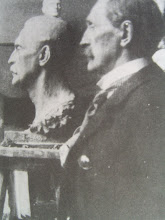
Para el hombre ciego en la habitación oscura que mira el gato negro que no está allí
Comisariada por Anthony Huberman en el Contemporary Art Museum de St. Louis, la exposición explora la naturaleza especulativa del conocimiento e insiste en la importancia de la curiosidad y las cosas que no sabemos. Ordenada a partir de la premisa de que el mundo -y el arte- no es un código que necesite descifrarse, las obras en el centro expositivo y sobre la infructuosidad del no-saber, no-aprender y la confusión productiva. David Hullfish Bailey, Marcel Broodthaers, Hans-Peter Feldmann, Fischli & Weiss, Rachel Harrison, Giorgio Morandi, Matt Mullican, Rosalind Nashashibi & Lucy Skaer, Frances Stark, Rosemarie Trockel y otros presentan explicaciones que traviesamente no explican. Celebra nuestra habilidad de perderse y las historias que usamos para encontrar el camino en la oscuridad.
For the blind man in the dark room looking for the black cat that isn't there: Perception is given close study in this elegant exhibit of work by an international (and historically broad) cast of artists. Positing itself in the Socratic tradition of inquiry limned only by endless discussion, the exhibit proposes that art, at best, is a speculative rather than declarative industry. In an audio piece, Marcel Broodthaers seeks answers to the hard questions of art's worth and purpose from a cat, who responds simply and perhaps wisely: meow. Coffee grounds are divined for larger meaning in a video by Ayse Erkmen (though the deepest wisdom seems to come from the mute chow dog, calmly surveying the chatty humans in his company). The meticulous and obsessive study of objects in themselves, in Giorgio Morandi's inimitable painted still lifes, appear twice and feel like hinge lines in the exhibit's extended villanelle. And the thousand and one drawn charts by Matt Mullican parsing birth, life and death like a mathematical equation — proliferate with the promise of solutions, albeit eternally elided. Antiquity flashes in a video of the Metropolitan Museum's Greek and Roman wing after dark, and the Renaissance Wunderkammer makes a requisite appearance in the form of an etching — suggesting at once the complementary truths of historical return and non-linearity. One leaves this exhibit — lightly, eruditely and playfully curated by Anthony Huberman — with a fresh faith in art's philosophical capacity and essential mystery. Through January 3, 2010, at the Contemporary Art Museum St. Louis, 3750 Washington Boulevard; 314-535-4660.
For the blind man in the dark room looking for the black cat that isn't there: Perception is given close study in this elegant exhibit of work by an international (and historically broad) cast of artists. Positing itself in the Socratic tradition of inquiry limned only by endless discussion, the exhibit proposes that art, at best, is a speculative rather than declarative industry. In an audio piece, Marcel Broodthaers seeks answers to the hard questions of art's worth and purpose from a cat, who responds simply and perhaps wisely: meow. Coffee grounds are divined for larger meaning in a video by Ayse Erkmen (though the deepest wisdom seems to come from the mute chow dog, calmly surveying the chatty humans in his company). The meticulous and obsessive study of objects in themselves, in Giorgio Morandi's inimitable painted still lifes, appear twice and feel like hinge lines in the exhibit's extended villanelle. And the thousand and one drawn charts by Matt Mullican parsing birth, life and death like a mathematical equation — proliferate with the promise of solutions, albeit eternally elided. Antiquity flashes in a video of the Metropolitan Museum's Greek and Roman wing after dark, and the Renaissance Wunderkammer makes a requisite appearance in the form of an etching — suggesting at once the complementary truths of historical return and non-linearity. One leaves this exhibit — lightly, eruditely and playfully curated by Anthony Huberman — with a fresh faith in art's philosophical capacity and essential mystery. Through January 3, 2010, at the Contemporary Art Museum St. Louis, 3750 Washington Boulevard; 314-535-4660.















2 comentarios:
Muy interesante...sobre todo eso de que el arte sea algo que no se necesita descifrar...a ver si aprenden los pedantes del mundo.
Crítico, el arte contemporáneo es tan críptico la mayoría de las veces que no viene mal que te den una explicación. Pero también es cierto que lo más divertido es descifrarlo por ti solo y dejarse llevar por la propia subjetividad.
Y como ocurre con las Wunderkammern tardorrenacentistas a veces lo que más te llama la atención es lo que te resulta más curioso, lo que te sorprende y confunde.
De ahí la obsesión de esta Chambre Denon... entre otras cosas, la búsqueda de Wunderkammern postmodernas.
¡Y gracias por comentar!
Publicar un comentario